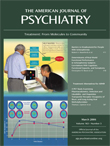Regional Brain Morphometry in Patients With Schizophrenia or Bipolar Disorder and Their Unaffected Relatives
Abstract
OBJECTIVE: Schizophrenia and psychotic bipolar disorder have a number of overlapping symptoms and risk factors, but it is not yet clear if the disorders are characterized by similar deviations in brain morphometry or whether any such deviations reflect the impact of shared susceptibility genes on brain structure. The authors used region-of-interest morphometry to volumetrically assess brain structures frequently implicated in psychotic illness in families affected with schizophrenia or psychotic bipolar disorder. METHOD: Magnetic resonance imaging brain scans were obtained from 243 subjects, comprising 42 patients with schizophrenia or schizoaffective disorder, 57 of their unaffected first-degree relatives, 38 patients with psychotic bipolar disorder, 52 of their unaffected first-degree relatives, and 54 healthy comparison subjects. Most of the families affected with schizophrenia and all of the families affected with bipolar disorder were multiply affected with the illness. Volumetric measurements of the cerebrum, lateral ventricles, third ventricle, and hippocampus were completed with stereological methods. RESULTS: Patients with schizophrenia had increased volume of the lateral and third ventricles and reduced hippocampal volume. None of these volumetric abnormalities was present in psychotic bipolar disorder. Unaffected relatives of patients with schizophrenia from multiply affected families had enlarged lateral ventricles but no other volumetric deviations. Unaffected relatives of patients with bipolar disorder showed preservation of ventricular and hippocampal volume. CONCLUSIONS: Schizophrenia and psychotic bipolar disorder are characterized by morphometric distinctions in ventricular and hippocampal regions. Lateral ventricular enlargement represents a potential morphometric endophenotype for schizophrenia.



